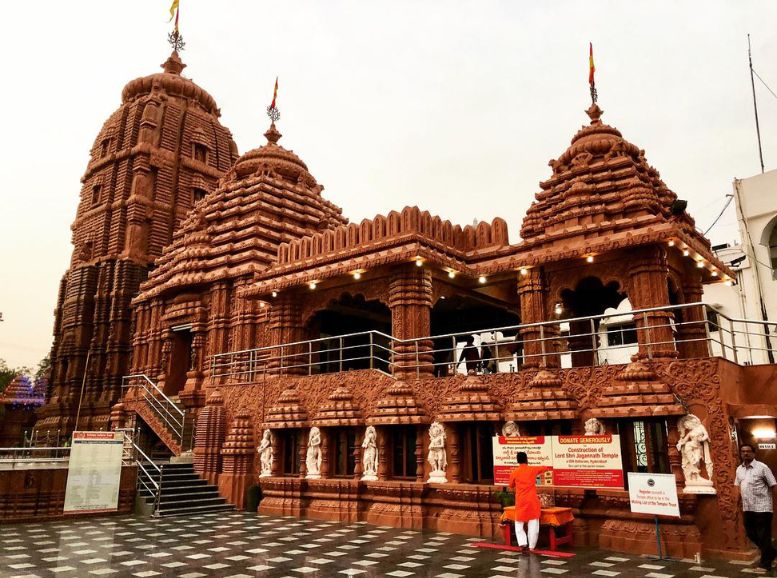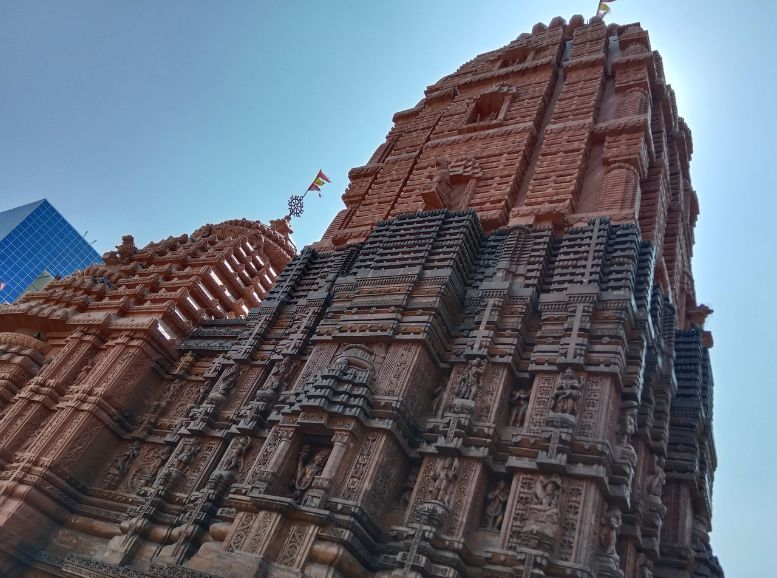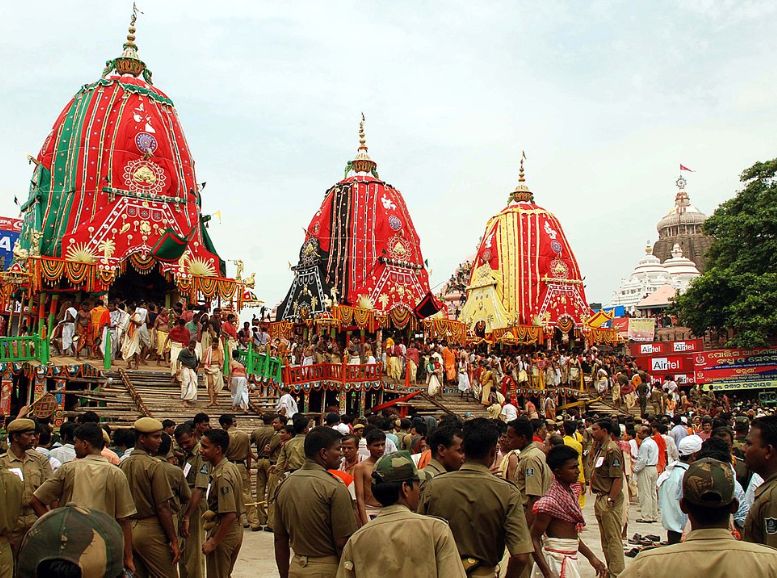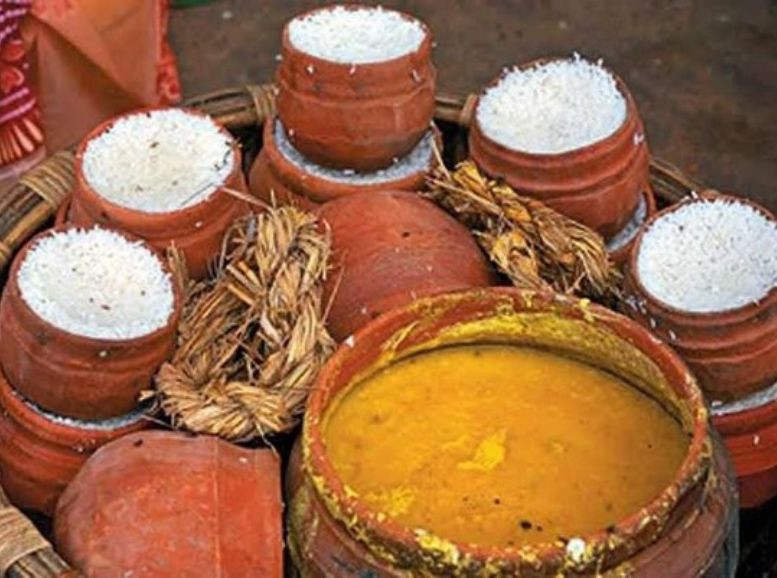Steeped in spirituality and cultural richness, the Jagannath Temple in Telangana stands as a testament to India’s enduring faith. While mirroring the grandeur of its iconic counterpart in Puri, Odisha, this temple offers a distinct and peaceful atmosphere. Here, age-old traditions seamlessly blend with the timeless devotion to Lord Jagannath. Exquisite craftsmanship adorns the structure, while vibrant rituals pulsate with life within its walls.
This guide serves as your portal to unlocking the captivating history, architectural marvels, and profound cultural significance of the Jagannath Temple. We’ll delve into its serene setting, explore the vibrant festivals that infuse the grounds with energy, and unveil the divine charm of this hidden gem in Telangana.
How to reach:
Air:
- Rajiv Gandhi International Airport (HYD) in Hyderabad is the closest airport.
- Well-connected domestically and internationally, it offers taxis and ride-hailing apps for the roughly 30-kilometer, one-hour journey (depending on traffic) to the temple.
Train:
- Hyderabad’s major railway stations include Secunderabad Junction, Hyderabad Deccan (Nampally), and Kacheguda, with extensive connections across India.
- Taxis, auto-rickshaws, or public buses can take you from these stations to the temple (approximately 20 kilometers away, with a 45-minute to 1-hour travel time).
Road:
- Hyderabad’s well-developed road network offers multiple options:
- Bus: The Telangana State Road Transport Corporation (TSRTC) provides frequent services within Hyderabad and neighboring cities. Take a bus to major stops like Mehdipatnam or Gachibowli, then transfer to a local bus or auto-rickshaw for the final leg.
- Car: The temple is easily accessible via Outer Ring Road (ORR) and major city roads. Ample parking is available near the temple premises.
Local Transport:
- Upon reaching Hyderabad, taxis, auto-rickshaws, and ride-hailing apps (like Ola and Uber) offer convenient options for getting around.
- Public buses also serve the area, with several routes passing near the Jagannath Temple.
Best time to visit:
Pleasant Comfort (October to February):
Winter reigns as the most comfortable time to visit. With cool temperatures between 15°C and 25°C (59°F and 77°F), exploring the temple and its surroundings becomes a delight. This period also allows for full participation in temple activities and ceremonies without the discomfort of scorching heat.
Serene Tranquility (June to September):
The monsoon season paints the temple and its environs a lush, vibrant green. While moderate to heavy rainfall can occasionally disrupt travel plans, it creates a unique and serene atmosphere with fewer crowds.
Planning for the Heat (March to May):
Telangana summers can be quite hot, with temperatures reaching between 30°C and 45°C (86°F and 113°F). If you choose to visit during this time, plan your temple visits for the cooler mornings or evenings.
Attractions:
Main Sanctum (Garbha Griha):

The Jagannath Temple’s heart lies within its main sanctum, the Garbha Griha. Here, the sacred idols of Lord Jagannath, his brother Balabhadra, and sister Subhadra reside. Exquisitely carved from wood, these figures stand adorned in vibrant garments and elaborate jewelry, embodying the rich heritage of devotional artistry.
Stepping into the sanctum, a profound sense of spirituality washes over you. The air thrums with the fragrance of incense and the melodic chants of devotees. This inner sanctum serves as a conduit to a deep spiritual connection, a place where one can feel the palpable presence of the divine. Pilgrims and visitors gather here to offer prayers, seeking blessings amidst the serene ambience that encapsulates centuries of devotion and tradition.
Jagannath Temple Architecture:

The Jagannath Temple stands as a magnificent testament to the Kalinga architectural style. Its grandeur and intricate design echo the finest traditions of ancient Indian temple architecture. Towering spires, known as Shikharas, pierce the sky, adorned with meticulous carvings of mythological motifs and religious symbols. The main entrance, the Simhadwaram, boasts beautifully sculpted pillars and ornate gateways that beckon visitors into the sanctum.
The temple walls themselves transform into a visual tapestry. Elaborate carvings depicting scenes from Hindu mythology grace the stone, showcasing the exceptional skill of the artisans. This architectural splendor is not merely a feast for the eyes; it serves as a testament to the profound cultural and historical significance of the region. Art and history enthusiasts will find the Jagannath Temple an utterly captivating destination.
Festivals and Rituals:

The Jagannath Temple pulsates with vibrant festivals and rituals, drawing devotees from far and wide. The pinnacle of these celebrations is the Rath Yatra, or Chariot Festival, held annually in June or July. This grand spectacle sees the deities take center stage on elaborately decorated chariots, paraded through the streets amidst fervent chanting, music, and dance. Thousands of devotees join in the joyous procession, pulling the chariots in a display of unwavering devotion and community spirit.
Beyond the Rath Yatra, other noteworthy festivals grace the temple throughout the year. Makar Sankranti, Holi, and Diwali, each come alive with special prayers, unique rituals, and captivating cultural performances. These festivals offer a once-in-a-lifetime opportunity to immerse yourself in the rich tapestry of the temple’s cultural and religious heritage.
Prasadam (Holy Offering):

No pilgrimage to the Jagannath Temple is complete without experiencing prasadam, the holy offering shared with devotees. Prepared with utmost devotion and following strict rituals to ensure its purity, this blessed food holds deep significance.
The prasadam typically encompasses a delightful array of traditional dishes, each boasting a unique flavor and symbolic meaning. Receiving prasadam is considered a divine blessing, believed to cleanse the mind and soul. Many visitors choose to take a portion home to share with loved ones, extending the temple’s blessings beyond its walls. Partaking in prasadam serves as a powerful act, forging a profound connection between devotees and the temple’s spiritual core and traditions.
Local Experiences:
- Engage in the Temple’s Spiritual Aura:
Participate in the temple’s daily rituals, absorbing the serenity of morning aarti, soulful devotional songs, and calming evening prayers.
- Savor Local Delights:
Tantalize your taste buds with Hyderabadi biryani, aromatic rice layered with meat or vegetables. Savor pesarattu, a green gram dosa, and Gongura chutney, a tangy and spicy condiment.
- Shopping Spree at Laad Bazaar:
Hunt for exquisite bangles, jewelry, and fabrics amidst the bustling lanes of Laad Bazaar, a historic market.
- Cultural Extravaganza at Shilparamam:
Witness live folk performances showcasing the region’s rich cultural heritage through dance and music. Participate in workshops to learn pottery, weaving, and painting from local artisans.
- Tranquil Escape at Hussain Sagar Lake:
Enjoy a peaceful boat ride on Hussain Sagar Lake and visit the iconic Buddha statue.
- Exploring the Historical Gems:
Embark on a guided tour of the Charminar area, known for its historical significance and architectural beauty. Visit nearby attractions like Mecca Masjid, one of the largest mosques in India, and Chowmahalla Palace, a sprawling palace complex. Explore the vibrant markets around Charminar and lose yourself in the local culture and history.
Travel tips:
Dress Modestly: Respect local customs by dressing modestly when visiting religious sites. Opt for traditional attire like sarees, salwar kameez, or long pants and shirts.
Temple Etiquette: Remove footwear before entering temple grounds and maintain silence and decorum within the sanctum.
Pleasant Weather: Plan your visit between October and February for comfortable weather. Avoid peak summer months (March-May) with scorching temperatures.
Stay Hydrated: Carry a water bottle, especially during warm weather or extended outdoor activities.
Cash for Convenience: While digital payments are increasingly common, carry some cash for smaller purchases, donations, and entry fees at local attractions.
Reliable Transportation: Choose reliable transportation options like app-based cabs (Uber, Ola) or pre-booked taxis for safety and convenience. Negotiate fares beforehand when using auto-rickshaws.
Stay Connected: Keep your phone charged and consider a local SIM card with internet access for navigation and communication.
Respect Temple Protocols: Photography restrictions may exist in certain temple areas. Always follow guidelines regarding photography and videography.
Quieter Visits: For a less crowded experience, visit the temple early mornings or late evenings.
Security Checks: Be prepared for security checks at the temple entrance. Avoid large bags or prohibited items like leather goods, food, and cameras (where restricted).
Safe Local Food: Enjoy local cuisine, but choose clean and reputable restaurants to avoid getting sick. Stick to bottled or filtered water.
Basic Telugu Phrases: Learning a few basic Telugu phrases can be helpful and appreciated by locals. English and Hindi are also widely spoken.
Emergency Preparedness: Keep a list of emergency contacts (local police, medical services, embassy/consulate) handy.
Wildlife and Environment: Respect local wildlife and the environment when visiting natural areas. Avoid littering and follow responsible tourism practices.
Conclusion
A trip to Telangana’s Jagannath Temple transcends a pilgrimage, offering a transformative experience that blends spirituality, culture, and history. The temple’s divine ambiance, pulsating with vibrant rituals and festivals, leaves you in awe. Venture beyond the temple walls to explore historical treasures, immerse yourself in cultural villages, and tantalize your taste buds with local delicacies. Whether seeking spiritual solace, cultural enrichment, or an off-the-beaten-path adventure, Telangana and the Jagannath Temple offer an unforgettable journey that leaves a lasting impression. Embrace it with an open mind and let the temple guide you on a voyage of discovery. To craft your perfect Telangana itinerary, visit Xplro.com for invaluable insights, hidden gems, and practical tips to make your adventure extraordinary.
FAQs
What is the significance of the Jagannath Temple in Telangana?
- The Jagannath Temple in Telangana holds immense importance as a revered Hindu pilgrimage site dedicated to Lord Jagannath.
Is the Jagannath Temple in Telangana affiliated with the Jagannath Temple in Puri, Odisha?
- No, they are independent establishments with distinct administrations and histories.
What is the history of the Jagannath Temple in Telangana?
- The history of the Jagannath Temple in Telangana dates back centuries, with evidence of its existence found in ancient records.
Are there any legends or myths associated with the Jagannath Temple?
- Yes, numerous legends and myths revolve around the Jagannath Temple, recounting tales of miracles and divine interventions.
What are the temple timings for darshan (worship)?
- The temple timings for darshan (worship) typically span from early morning to late evening, although they may vary based on specific events or festivals.
Can non-Hindus visit the Jagannath Temple?
- Yes, the Jagannath Temple welcomes visitors of all faiths to experience its spiritual ambiance and architectural beauty.
Are there facilities available for prasad distribution and offerings?
- Yes, the temple provides facilities for prasad distribution and offerings, allowing devotees to receive blessed food and make offerings to the deity.
What are the transportation options available to reach the Jagannath Temple?
- Visitors can access the Jagannath Temple via various transportation modes, including taxis, auto-rickshaws, buses, and app-based cab services.
Are there any accommodations available near the Jagannath Temple for overnight stays?
- Yes, there are several hotels, lodges, and guesthouses in the vicinity of the Jagannath Temple that cater to overnight visitors.
Can visitors take photographs inside the temple premises?
- Photography inside the temple premises may be restricted in certain areas; visitors should inquire with temple authorities regarding photography guidelines.
What should visitors wear when visiting the Jagannath Temple?
- Visitors are advised to dress modestly and conservatively as a sign of respect when visiting the Jagannath Temple.
Are there any nearby attractions or places of interest to visit along with the Jagannath Temple?
- Yes, the surrounding area offers various attractions, including historical landmarks, cultural sites, and natural wonders, providing visitors with diverse experiences.





